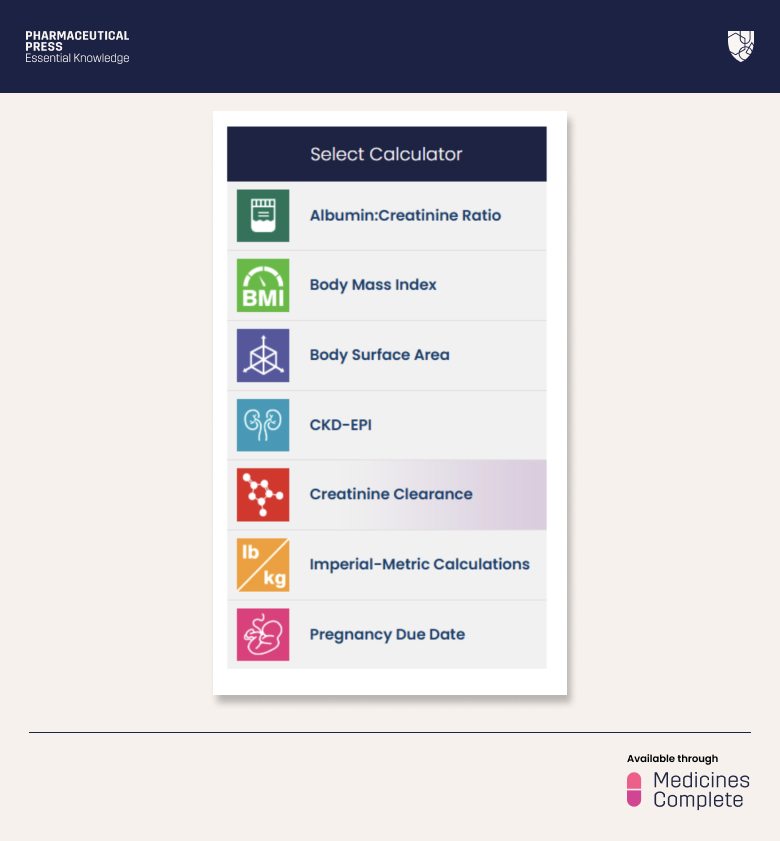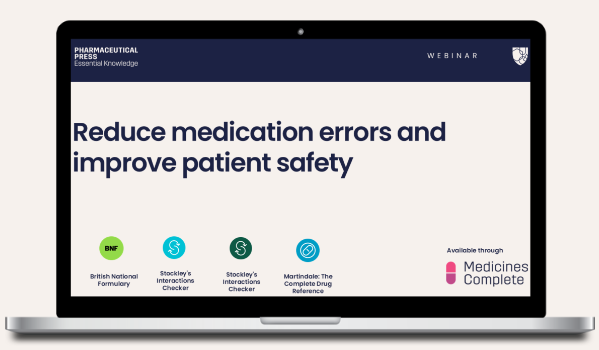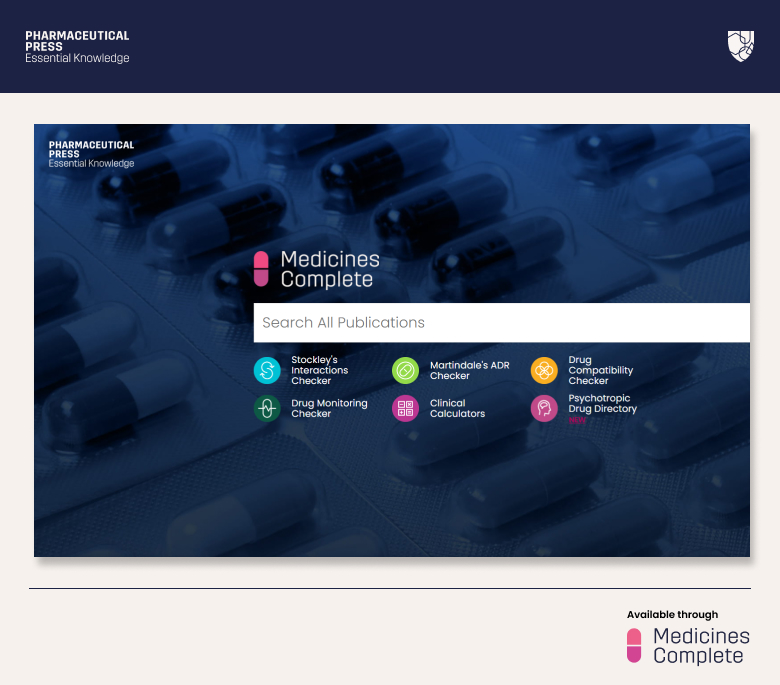How to calculate creatinine clearance
Creatinine clearance (CrCl) is a key measurement used to estimate kidney function and guide safe drug prescribing.¹ ² Measured glomerular filtration rate (GFR), typically determined from a 24-hour urine collection, provides the most accurate assessment of renal function. While estimated glomerular filtration rate (eGFR) is generally recommended over CrCl, there are specific clinical situations where calculating CrCl remains appropriate.
The simplest way to calculate creatinine clearance is by using the Creatinine Clearance Calculator on MedicinesComplete, which applies the well-known Cockcroft and Gault equation.³
Please complete the form at the bottom of this article to request a complimentary trial of MedicinesComplete.
Why calculate creatinine clearance?
Creatinine clearance is calculated to estimate a patient’s GFR, a key marker of kidney function.¹ ² ⁴ ⁵ Understanding renal function is essential because impaired clearance can affect how drugs are metabolised and excreted.¹ ² ⁴ ⁵
If not adjusted correctly, medicines may:
- Accumulate and cause toxicity
- Have exaggerated side effects in patients with reduced renal function
- Be less effective when clearance is impaired.
Checking renal function before prescribing allows health professionals to reduce doses, extend dosing intervals, or choose alternative therapies. This is particularly important for narrow therapeutic index medicines and drugs such as direct oral anticoagulants (DOACs).¹
Using the MedicinesComplete creatinine clearance calculator
To calculate creatinine clearance using the MedicinesComplete tool, you simply enter:
- Age (in years)
- Sex (male or female)
- Weight (kg, using ideal body weight where appropriate)
- Serum creatinine (micromol/L).
The calculator then applies the Cockcroft and Gault formula to generate an estimated CrCl in mL/minute.
Important caveats
While the Cockcroft and Gault formula is valuable, it has several limitations:
- It can overestimate or underestimate renal function in patients with very low or high muscle mass
- It is not reliable in acute kidney injury (AKI), when creatinine levels change rapidly
- It should be interpreted cautiously in conditions such as malnutrition, muscle wasting, or in bodybuilders.¹ ²
Cockcroft-Gault vs estimated glomerular filtration rate (eGFR)
Although estimated GFR, usually calculated using the Chronic Kidney Disease Epidemiology Collaboration (CKD-EPI) equation, is the preferred measure for most patients, there are important situations where calculating CrCl using the Cockcroft and Gault equation should be used:
- Elderly patients (≥75 years)
- Patients at extremes of muscle mass (BMI <18 or >40 kg/m²)
- Drugs with a narrow therapeutic index that are renally cleared (e.g. digoxin).¹ ⁴ ⁵
Chronic Kidney Disease Epidemiology Collaboration (CKD-EPI) formula
The CKD-EPI formula is the recommended method for estimating GFR and calculating drug doses in most patients with renal impairment.¹ ⁴ ⁵
CKD-EPI is adjusted for body surface area (BSA) and utilises serum creatinine, age, and sex as variables.
MedicinesComplete clinical calculators

The creatinine clearance calculator and CKD-EPI are two of several tools available on the MedicinesComplete homepage.³ These calculators are designed to support everyday clinical practice, including:
- Basic measurement conversions
- Body surface area
- Ideal body weight.
By centralising these tools, MedicinesComplete helps health professionals make safe, evidence-based decisions more quickly.
Calculating creatinine clearance is an essential step in tailoring drug therapy to patients with renal impairment. While eGFR is widely reported in practice, calculating CrCl using the Cockcroft and Gault formula remains the standard in certain patient groups and for specific medicines.
The MedicinesComplete calculators provides a quick, reliable way to apply this formula, supporting safer prescribing decisions. Alongside other MedicinesComplete tools and resources, it enables health professionals to optimise patient care by balancing drug efficacy with safety.
Trial form
Please complete the form below to request a complimentary trial to knowledge products through MedicinesComplete.
References
1. Joint Formulary Committee (2025). Prescribing in renal impairment (updated 20/05/2024). British National Formulary. Available at: www.medicinescomplete.com (accessed 20/08/2025).
2. Pharmaceutical Press. Drug Monitoring Checker. Available at: www.medicinescomplete.com (accessed 20/08/2025).
3. Pharmaceutical Press. Clinical Calculators. Available at: www.medicinescomplete.com (accessed 22/10/2025).
4. UK Kidney Association.UK Kidney Association. UK Measurement of Kidney Function (issued 2021). Available at: https://www.ukkidney.org/health-professionals/information-resources/uk-eckd-guide/measurement-kidney-function (accessed 20/08/2025).
5. UK Renal Pharmacy Group. Drug Dosing in Renal Impairment and Dialysis (issued 2020). Available at: https://www.ukkidney.org/sites/renal.org/files/RPG/RPG%20Drug%20Dosing%20Leaflet%202020.pdf (accessed 20/08/2025).








